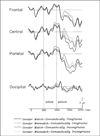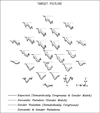Expecting gender: an event related brain potential study on the role of grammatical gender in comprehending a line drawing within a written sentence in Spanish
- PMID: 12870823
- PMCID: PMC3392191
- DOI: 10.1016/s0010-9452(08)70260-0
Expecting gender: an event related brain potential study on the role of grammatical gender in comprehending a line drawing within a written sentence in Spanish
Abstract
Event-related brain potentials (ERPs) were used to examine the role of grammatical gender in written sentence comprehension. Native Spanish speakers read sentences in which a drawing depicting a target noun was either congruent or incongruent with sentence meaning, and either agreed or disagreed in gender with that of the preceding article. The gender-agreement violation at the drawing was associated with an enhanced negativity between 500 and 700 msec post-stimulus onset. Semantically incongruent drawings elicited a larger N400 than congruent drawings regardless of gender (dis)agreement, indicating little effect of grammatical gender agreement on contextual integration of a picture into a written sentence context. We also observed an enhanced negativity for articles with unexpected relative to expected gender based on prior sentence context indicating that readers generate expectations for specific nouns and their articles.
Figures






References
-
- Bates E, D’Amico S, Jacobsen T, Szekely A, Andonova E, Devescovi A, Herrod D, Lu CC, Pechmann T, Pleh C, Wicha NYY, Federmejer K, Gerdjikova I, Gutierrez G, Hung D, Hsu J, Iyer G, Kohnertk, Memotcheva T, Orozco-Figueroa A, Tzeng A, Tzeng O. Timed picture naming in seven languages. Psychonomic Bulletin and Review. in press. - PMC - PubMed
-
- Bates E, Devescovi A, Hernandez A, Pizzamiglio L. Gender priming in Italian. Perception and Psychophysics. 1996;58:992–1004. - PubMed
-
- Bates E, Devescovi A, Pizzamiglio L, D'Amico S. Gender and lexical access in Italian. Perception and Psychophysics. 1995;57:847–862. - PubMed
-
- Bentrovato S, Devescovi A, D'Amico S, Bates E. Effect of grammatical gender and semantic context on lexical access in Italian. Journal of Psycholinguistic Research. 1999;28:677–693. - PubMed
-
- Brown CM, van Berkum JJA, Hagoort P. Discourse before gender: An event-related brain potential study on the interplay of semantic and syntactic information during spoken language understanding. Journal of Psycholinguistic Research. 2000;29:53–68. - PubMed
Publication types
MeSH terms
Grants and funding
LinkOut - more resources
Full Text Sources

